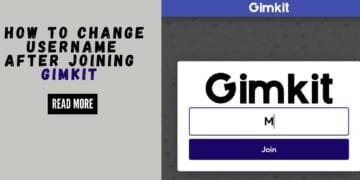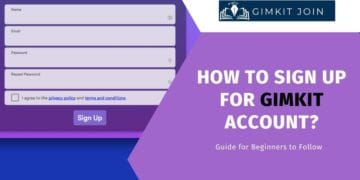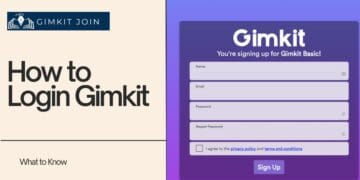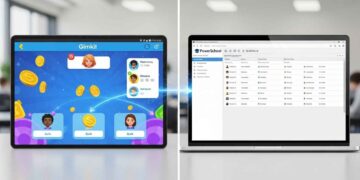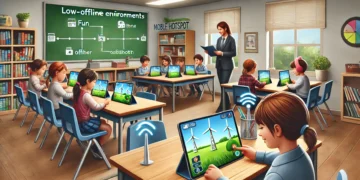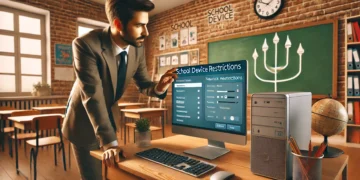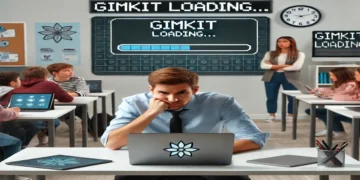The bell rings, students are buzzing, devices are out – and then Gimkit freezes. Oh, the frustration! Nothing sours a fun lesson faster than Gimkit connectivity issues. In today’s diverse classroom tech landscape, a stable internet connection is the invisible backbone of engaging edtech.
We’ve all been there. Trying to run an exciting Gimkit game, only to be met with “Reconnecting…” messages, endless loading screens, or students yelling, “It’s lagging!” Teachers everywhere wrestle with limited internet access, network congestion, or a large number of devices all trying to grab a piece of that precious Wi-Fi at once. It’s tough, and you’re not alone.
This comprehensive guide is here to help. We’ll provide practical advice, Gimkit low bandwidth tips, and troubleshooting strategies. Our goal is to help you navigate the classroom network for Gimkit challenges and ensure seamless, uninterrupted gameplay for all students, no matter your school’s internet limitations or the device-specific nuances of their tech.
Understanding the Foundation: Bandwidth, Latency & Gimkit’s Needs
Before we dive into solutions, let’s quickly understand the tech terms. Knowing these helps you speak to your IT department or understand why things are acting up.
What is Bandwidth? (The “Pipe Size”)
 Think of your internet connection as a water pipe.
Think of your internet connection as a water pipe.
Definition: How much data can pass through at once?
Bandwidth is like the width of that pipe. A wider pipe means more water (data) can flow through at the same time. It’s measured in megabits per second (Mbps).
Impact on Gimkit: Direct impact on loading times and how many players can connect smoothly.
If your pipe is too narrow, Gimkit might take ages to load. Or it might struggle when many students try to play at once. You need enough “pipe” for all those active learners.
What is Latency? (The “Time Delay”)
 Now, think about how long it takes for water to travel through the pipe.
Now, think about how long it takes for water to travel through the pipe.
Definition: The time it takes for data to travel from your device to Gimkit’s servers and back.
Latency is the delay. It’s often called “ping.” It’s measured in milliseconds (ms). Lower numbers are better.
Impact on Gimkit: Causes “lag,” delayed reactions, and disconnections
High latency is the reason for that annoying “lag.” It makes game actions feel slow. You click to answer a question, but nothing happens for a second or two. This can really frustrate students and lead to Gimkit freezing during gameplay, which needs a fix. If you’re consistently seeing these issues, our detailed guide on troubleshooting Gimkit lag offers more in-depth solutions.
Gimkit’s Core Internet Requirements (Straight from the Source!)
 Gimkit is designed to be accessible. But like any online game, it needs certain things to run well.
Gimkit is designed to be accessible. But like any online game, it needs certain things to run well.
Web-Based Platform: It lives in your browser
Gimkit runs right in your web browser. This means it needs stable, real-time communication with its servers. It’s constantly sending and receiving tiny bits of data. This keeps the game moving for everyone.
Player Limits & 2D Modes: Some modes need more “oomph.”
 Gimkit itself states that the number of players can depend on internet reliability. They have a hard limit of 500 students for most live games. But for graphic-heavy 2D game modes (like Fishtopia or Don’t Look Down), the limit is lower – usually 60 students. Why? Because these modes are way more demanding on your network. They send more visual updates and constant interactions. This means they’re tougher on your classroom network for Gimkit.
Gimkit itself states that the number of players can depend on internet reliability. They have a hard limit of 500 students for most live games. But for graphic-heavy 2D game modes (like Fishtopia or Don’t Look Down), the limit is lower – usually 60 students. Why? Because these modes are way more demanding on your network. They send more visual updates and constant interactions. This means they’re tougher on your classroom network for Gimkit.
Domain Whitelisting: Don’t let your school firewall block the fun!
 This is super important for schools! Sometimes, school networks have firewalls or content filters. These can block Gimkit from working. To make sure Gimkit always loads, your IT department might need to “whitelist” these specific web addresses: *.gimkit.com, *.gimkitconnect.com, and *.unsplash.com. If students are asking “how to fix Gimkit not loading,” this is often the first thing to check with IT. For a broader look at common reasons Gimkit might not load, we have a dedicated guide.
This is super important for schools! Sometimes, school networks have firewalls or content filters. These can block Gimkit from working. To make sure Gimkit always loads, your IT department might need to “whitelist” these specific web addresses: *.gimkit.com, *.gimkitconnect.com, and *.unsplash.com. If students are asking “how to fix Gimkit not loading,” this is often the first thing to check with IT. For a broader look at common reasons Gimkit might not load, we have a dedicated guide.
Proactive Measures: Pre-Game Network Checks & Setup
A little preparation goes a long way. These steps can prevent many Gimkit connectivity issues before they even start.
Running a Classroom Speed Test
Knowledge is power!
Recommended Tools: Get an idea of your speed
 Before a big Gimkit session, run a quick internet speed test. You can easily do this by searching “internet speed test” on Google, or go to a dedicated site like Speedtest.net.
Before a big Gimkit session, run a quick internet speed test. You can easily do this by searching “internet speed test” on Google, or go to a dedicated site like Speedtest.net.
Interpreting Results: What’s a “good enough” speed?
 This is tricky, as Gimkit doesn’t publish exact Gimkit minimum bandwidth per student figures. However, based on general edtech recommendations and user experiences, here’s a rough idea:
This is tricky, as Gimkit doesn’t publish exact Gimkit minimum bandwidth per student figures. However, based on general edtech recommendations and user experiences, here’s a rough idea:
- For 30 students in a regular Gimkit game: Aim for at least 30-60 Mbps download speed total for the classroom. This breaks down to about 1-2 Mbps per active student. However, remember that all devices, even those not actively playing, use some bandwidth.
- For 2D modes or large classes (60+ students): You’ll ideally want more, perhaps 80-100+ Mbps download.
- Upload speed is also important, especially for the teacher’s device hosting the game. Aim for at least 5-10 Mbps upload. If your speeds are much lower, you might experience Gimkit performance on slow internet.
Ideal Location: Test where you play
 Always run the speed test from the exact classroom. Do it from the device you’ll use to host Gimkit. And from a student device. This gives you the most accurate picture of your real-world classroom network for Gimkit performance.
Always run the speed test from the exact classroom. Do it from the device you’ll use to host Gimkit. And from a student device. This gives you the most accurate picture of your real-world classroom network for Gimkit performance.
Optimizing Your Wi-Fi Environment
Even small changes can help.
Reduce Interference: Clear the airwaves
 Other electronics can mess with Wi-Fi signals. Microwaves, cordless phones, and even some projectors can cause interference. Try to keep them away from your Wi-Fi access points.
Other electronics can mess with Wi-Fi signals. Microwaves, cordless phones, and even some projectors can cause interference. Try to keep them away from your Wi-Fi access points.
Close Proximity to Access Points: Get closer to the source
 The closer your devices are to a Wi-Fi router or access point, the stronger and more stable the signal. If possible, host your game near one.
The closer your devices are to a Wi-Fi router or access point, the stronger and more stable the signal. If possible, host your game near one.
Reduce Competing Traffic: Ask for quiet on the network!
 Before starting Gimkit, ask students to close unnecessary tabs. Tell them to close other apps. This includes streaming video, social media, or even large file downloads. Every little bit helps to free up bandwidth for Gimkit. This is a key Gimkit low-bandwidth tip.
Before starting Gimkit, ask students to close unnecessary tabs. Tell them to close other apps. This includes streaming video, social media, or even large file downloads. Every little bit helps to free up bandwidth for Gimkit. This is a key Gimkit low-bandwidth tip.
Device-Specific Pre-Checks (It’s not just the network!)
Your devices play a part too. For more detailed device-specific tips, check out our comprehensive guide on optimizing Gimkit for various devices.
Clear Browser Cache & History: A digital spring clean
 Your browser stores temporary files (cache and cookies). Over time, these can slow things down. Clearing them regularly frees up resources. It also ensures a clean connection to Gimkit. This can often help with how to fix Gimkit not loading.
Your browser stores temporary files (cache and cookies). Over time, these can slow things down. Clearing them regularly frees up resources. It also ensures a clean connection to Gimkit. This can often help with how to fix Gimkit not loading.
Close Unnecessary Tabs/Apps: Declutter your digital workspace
 Just like clearing competing network traffic, closing tabs and apps on individual devices reduces strain. It helps both the device’s processing power and its network usage. This is vital for Gimkit’s performance on slow internet.
Just like clearing competing network traffic, closing tabs and apps on individual devices reduces strain. It helps both the device’s processing power and its network usage. This is vital for Gimkit’s performance on slow internet.
Browser Updates: Stay fresh and fast
 Make sure students are using the latest version of their web browser (Chrome, Firefox, Safari, Edge). Browser updates often include performance improvements that can significantly impact streaming game performance and web apps like Gimkit.
Make sure students are using the latest version of their web browser (Chrome, Firefox, Safari, Edge). Browser updates often include performance improvements that can significantly impact streaming game performance and web apps like Gimkit.
Strategic Play: Gimkit Low Bandwidth Tips & Game Mode Selection
You can adapt your Gimkit strategy to fit your network’s capabilities.
Choosing Lower-Bandwidth Gimkit Modes
Not all Gimkit modes are created equal when it comes to internet use.
Classic Mode: Your old, reliable friend
 Classic Mode is often the most forgiving. It has simpler visuals and less continuous interaction. This means it usually uses less data. It’s often the best Gimkit game mode for low internet.
Classic Mode is often the most forgiving. It has simpler visuals and less continuous interaction. This means it usually uses less data. It’s often the best Gimkit game mode for low internet.
Assignments: The “Offline-like” Solution (Simulated Pre-Loading)
 Gimkit doesn’t have a true “offline mode” where you can download everything and play without internet. However, Assignments are the closest thing to Gimkit pre-loading questions for offline work.
Gimkit doesn’t have a true “offline mode” where you can download everything and play without internet. However, Assignments are the closest thing to Gimkit pre-loading questions for offline work.
- Concept: Assignments let students complete Gimkit Kits asynchronously. They do it on their own time, not in real-time during class.
- Benefits: This drastically reduces the real-time network load during your class time. Students can complete them at home with better internet. Or during quieter times at school. It’s a fantastic way to utilize Gimkit without stressing your classroom network for Gimkit.
Ditch the 2D Modes for Laggy Networks: Save those for strong Wi-Fi
 As we discussed, modes like Fishtopia, Don’t Look Down, or anything built with “Gimkit Creative” are much more demanding. If you’re constantly fighting Gimkit lag, save these modes for days when you have guaranteed strong internet. They generate a lot more network latency and data.
As we discussed, modes like Fishtopia, Don’t Look Down, or anything built with “Gimkit Creative” are much more demanding. If you’re constantly fighting Gimkit lag, save these modes for days when you have guaranteed strong internet. They generate a lot more network latency and data.
Adjusting Game Settings for Performance
 Even within a game mode, you have options! These are great tips for using Gimkit with many devices.
Even within a game mode, you have options! These are great tips for using Gimkit with many devices.
Shorter Game Times/Cash Goals: Less time, less data
A shorter game means less continuous data exchange. If you’re noticing Gimkit freezing during gameplay, fix issues, try setting shorter time limits or lower cash goals.
Simpler Power-Up Combinations: Reduce complexity
Some complex power-up interactions can add to the network strain. If you have a very weak connection, try simplifying the power-up options or even turning some off.
Manage Player Count: Sometimes, less is more
 Gimkit specifies player limits, but if you have a very large class (e.g., 50+ students) on a truly weak Wi-Fi, even Classic mode might struggle. If possible, consider splitting the class into two separate Gimkit games. Or even playing on different Wi-Fi channels if your IT can set that up. This reduces network congestion.
Gimkit specifies player limits, but if you have a very large class (e.g., 50+ students) on a truly weak Wi-Fi, even Classic mode might struggle. If possible, consider splitting the class into two separate Gimkit games. Or even playing on different Wi-Fi channels if your IT can set that up. This reduces network congestion.
Troubleshooting Gimkit Connectivity Issues During Play
Despite your best efforts, problems can still pop up. Here’s what to do when Gimkit connectivity issues strike mid-game.
Common Symptoms of Network Problems
Recognizing the signs helps you act fast.
“Something Went Wrong” Error Messages: The generic cry for help
 These messages are often frustratingly vague. But they can definitely point to underlying Gimkit internet requirements not being met.
These messages are often frustratingly vague. But they can definitely point to underlying Gimkit internet requirements not being met.
Constant Disconnections/Reconnections: The dreaded “Reconnecting…”
 This is a classic sign of unstable Wi-Fi or high network latency. Students might see “Reconnecting…” popping up frequently.
This is a classic sign of unstable Wi-Fi or high network latency. Students might see “Reconnecting…” popping up frequently.
Extreme Lag/Unresponsive Gameplay: When actions just won’t register
 You click, nothing happens. Or the game moves in slow motion. This is a clear indicator of Gimkit’s performance on slow internet.
You click, nothing happens. Or the game moves in slow motion. This is a clear indicator of Gimkit’s performance on slow internet.
Students Unable to join: The game code isn’t working
 If students repeatedly can’t join the game code or get stuck on an infinite loading screen, it often means a connection problem.
If students repeatedly can’t join the game code or get stuck on an infinite loading screen, it often means a connection problem.
Immediate Teacher Actions
You can try these quick fixes yourself.
Check Gimkit’s Status Page: Rule out the big stuff
 First, check Gimkit’s official status page (or sites like IsDown.app for the current Gimkit status. This tells you if the problem is on Gimkit’s end. If their servers are having issues, there’s not much you can do but wait.
First, check Gimkit’s official status page (or sites like IsDown.app for the current Gimkit status. This tells you if the problem is on Gimkit’s end. If their servers are having issues, there’s not much you can do but wait.
Restart the Host Browser/Device: Give it a fresh start
 For the teacher’s machine, simply restarting the browser tab or even the entire device can often clear up glitches.
For the teacher’s machine, simply restarting the browser tab or even the entire device can often clear up glitches.
Student Device Restart: The classic tech fix
 Tell students to quickly restart their device. This can resolve many local memory or network adapter issues.
Tell students to quickly restart their device. This can resolve many local memory or network adapter issues.
Rejoin Game Code: Get back in the action
 Often, students can simply try re-entering the game code. Gimkit’s “Join Late” feature is a lifesaver for this.
Often, students can simply try re-entering the game code. Gimkit’s “Join Late” feature is a lifesaver for this.
When to Involve School IT
Sometimes, you need backup. Your IT department is your ally in edtech troubleshooting guides.
Persistent Issues Across Multiple Classes: It’s a bigger problem
 If you’re seeing consistent Gimkit connectivity issues across different classrooms, at different times, or with multiple teachers, that’s a clear sign of a broader educational technology network infrastructure problem. This is when you must reach out to your IT team.
If you’re seeing consistent Gimkit connectivity issues across different classrooms, at different times, or with multiple teachers, that’s a clear sign of a broader educational technology network infrastructure problem. This is when you must reach out to your IT team.
Firewall or Content Filter Blocks: They have the keys
 If you suspect Gimkit domains are being blocked, IT can check and.
If you suspect Gimkit domains are being blocked, IT can check and.
Wi-Fi Access Point Performance: Get a network health check
 If certain areas of the school always have issues, ask IT to check the Wi-Fi access points. They can test coverage and performance.
If certain areas of the school always have issues, ask IT to check the Wi-Fi access points. They can test coverage and performance.
Bandwidth Upgrades: Advocate for more internet power
 If issues are chronic and widespread, it might be time to advocate for increased internet capacity. This is especially true if you have many students and devices.
If issues are chronic and widespread, it might be time to advocate for increased internet capacity. This is especially true if you have many students and devices.
Long-Term Strategies for a Robust Classroom Network
These steps are more for school IT or administrators, but knowing about them empowers you to have better conversations.
Collaborate with Your IT Department
 They’re your partners in classroom management tech. For a deeper dive into broader classroom technology management strategies, explore our dedicated guide.
They’re your partners in classroom management tech. For a deeper dive into broader classroom technology management strategies, explore our dedicated guide.
Share Your Needs: Help them understand
 Explain to your IT department how you use edtech tools like Gimkit. Tell them your specific requirements. Provide concrete examples of when and where Gimkit connectivity issues occur.
Explain to your IT department how you use edtech tools like Gimkit. Tell them your specific requirements. Provide concrete examples of when and where Gimkit connectivity issues occur.
Provide Feedback: Be specific
 When you report issues, include as much detail as possible: time, date, classroom, number of students, devices used, and the exact symptoms.
When you report issues, include as much detail as possible: time, date, classroom, number of students, devices used, and the exact symptoms.
Understand School Network Policies: Work within the rules
 Learn about any existing network limitations or recommended practices. This helps you plan your Gimkit sessions more effectively.
Learn about any existing network limitations or recommended practices. This helps you plan your Gimkit sessions more effectively.
Consider Network Segmentation (for IT/Admin)
This is a technical way to prioritize.
Separate Networks for Guests/Students/Staff: Control the flow
 IT might be able to create separate Wi-Fi networks. For example, one for guest devices, one for student devices, and one for staff. This can help prioritize critical traffic, like live teaching applications.
IT might be able to create separate Wi-Fi networks. For example, one for guest devices, one for student devices, and one for staff. This can help prioritize critical traffic, like live teaching applications.
Quality of Service (QoS): Make Gimkit a priority
 QoS settings allow IT to prioritize network traffic with QoS to ensure essential applications get the bandwidth they need. They could, for instance, give higher priority to educational applications like Gimkit over general web browsing or streaming. This is advanced school Wi-Fi optimization.
QoS settings allow IT to prioritize network traffic with QoS to ensure essential applications get the bandwidth they need. They could, for instance, give higher priority to educational applications like Gimkit over general web browsing or streaming. This is advanced school Wi-Fi optimization.
Update and Maintain Network Hardware
Old equipment can be a bottleneck.
Routers & Access Points: Out with the old
 Older Wi-Fi routers and access points might not be able to handle modern classroom demands. Upgrading to newer hardware can significantly improve your educational technology network infrastructure. Consider reviewing educational technology network infrastructure best practices from organizations like ISTE.
Older Wi-Fi routers and access points might not be able to handle modern classroom demands. Upgrading to newer hardware can significantly improve your educational technology network infrastructure. Consider reviewing educational technology network infrastructure best practices from organizations like ISTE.
Firmware Updates: Keep everything current
 Just like browser updates, network hardware needs firmware updates. These can improve performance, fix bugs, and enhance security.
Just like browser updates, network hardware needs firmware updates. These can improve performance, fix bugs, and enhance security.
Conclusion
The buzzing excitement of a Gimkit game is a fantastic sight in any classroom. Don’t let Gimkit connectivity issues dim that spark. While the challenges of internet speed, bandwidth, and Wi-Fi can be frustrating, understanding Gimkit’s internet requirements and employing strategic Gimkit low bandwidth tips can significantly improve your classroom experience.
You have the power to influence your lessons! Don’t let a temperamental Wi-Fi signal dictate your lessons. With these proactive steps and troubleshooting know-how, you can confidently run Gimkit for large classes and ensure every student enjoys seamless, engaging play. Say goodbye to Gimkit lag and hello to uninterrupted learning!
What are your best classroom network tips for Gimkit? How do you deal with Gimkit connectivity issues in your school? Join Gimkit and share your experiences and solutions in the comments below! We’re all in this together!






